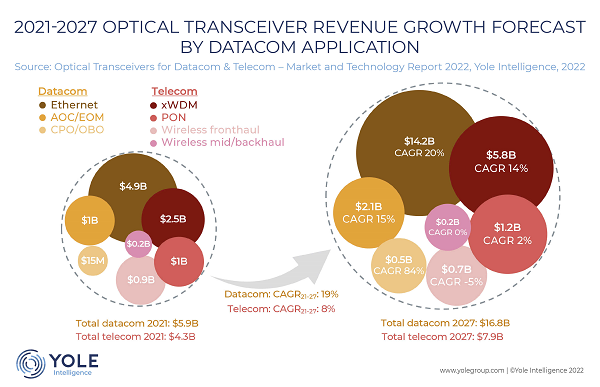For each decade over the past 50 years, there have been new mobile technology innovations. Mobile bandwidth requirements have evolved from voice calls and texting to UHD video and a variety of AR/VR applications. Despite the profound implications of the COVID-19 outbreak for the telecom infrastructure supply chain, consumers and business users worldwide continue to demand new networking and cloud services.
Martin Vallo, Ph.D., Senior Analyst, Photonics, specializing in optical communication and semiconductor lasers within the Photonics and Sensing division at Yole Intelligence, part of Yole Group, asserts: “Revenue generated by the optical transceiver market reached around US$10.4 billion in 2021 and is expected to reach US$24.7 billion in 2027, which is a 15% CAGR for 2021-2027. This growth is driven by high volume adoption of high-data-rate modules above 400G by big cloud service operators and national telecom operators requiring increased fiber-optic network capacity.”…
The evolution of multiple technologies has enabled data rates of 400G, 600G, 800G, and beyond across data center infrastructure and in long-haul and metro networks. 400GbE deployments are ramping across data center networks. Many cloud providers and telecom operators are now starting to deploy an 800Gbps optical ecosystem to increase bandwidth capacity and keep pace with the growing demand for data.
Today’s modern Ethernet-switch ASICs providing 25.6 Tb/s total capacity are running at a 50Gbps SerDes lane rate driven by 50G PAM-4 modulation technology. In line cards, a retimer is typically needed to synchronize PAM-4 data from the switch to the optical interface. In 400G optical modules, an additional silicon gearbox chip can be used to convert 50G PAM-4 electrical I/Os to 100G per wavelength optical I/Os to connect to 100G single-wavelength optics.
The next generation of ASIC chips expected in 2023 will provide 51.2 Tb/s total capacity and run at a 100Gbps SerDes lane rate. This significantly simplifies electro-optic conversion within the switch system and accelerates the exchange of high-speed optical modules. We anticipate high popularity for 800G modules as they take advantage of 100G single-wavelength optics already proven in 400GbE systems and thus can be technically and cost-effectively implemented in QSFP-DD and OSFP form factors.
Social networking, business meetings, video streaming in UHD, e-commerce, and gaming applications will continue to drive growth. With the advent of new digital devices with improved capabilities and intelligence, we observe higher adoption rates each year. In addition, expanding machine-to-machine applications, such as smart meters, video surveillance, healthcare monitoring, connected drives, and automated logistics, contribute significantly to device and connection growth and push the expansion of data center infrastructure.
Optical modules have become an essential technology in telecommunication infrastructure. The development of semiconductor technologies such as lasers, modulators, and DSPs has enabled increased bandwidth and accelerated data rates. Optical interconnects are ubiquitous and are intended to provide high bandwidth even for very short-reach applications, such as high-power computing and AI/ML applications within data centers. SiPh as a technology platform, co-packaged optics assembly as a new switch architecture, and coherence in compact form factors are the trends that will drive the market for the next five years.


















